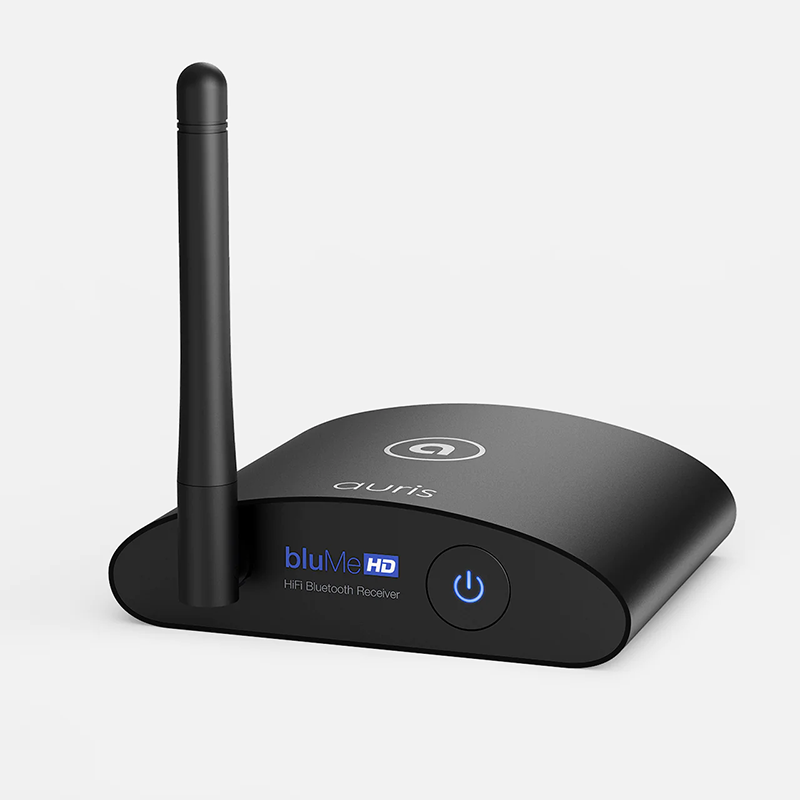
Modern-day technology has allowed us to forget about the value of Bluetooth capability. It’s built-in to nearly all of our smart devices these days, and most people use Bluetooth daily without even giving it a second thought.
But what about those slightly older devices that aren’t necessarily Bluetooth capable?
This is where Bluetooth audio receivers can come in handy. Let’s talk about how you can use a Bluetooth receiver device and the many benefits of owning one.
Table Of Contents
- What Is A Bluetooth Audio Receiver?
- How Does Bluetooth Work?
- Benefits Of A Bluetooth Audio Receiver
- Real-Life Applications For Bluetooth Audio Receivers
- 4 Fun Ways To Use A Bluetooth Receiver
- How To Find The Best Bluetooth Audio Receiver
- About Auris
What Is A Bluetooth Audio Receiver?

A Bluetooth audio receiver is a specialized type of device that adds Bluetooth wireless compatibility to other devices without built-in Bluetooth.
Bluetooth audio receivers allow you to connect a non-Bluetooth device to your smartphone or other Bluetooth-enabled device and stream from them. This includes speakers, docking stations, HiFi, headphones, and car stereos.
By connecting the Bluetooth receiver to one of these pieces of hardware and then syncing the receiver with your smartphone or computer, you can play music, podcasts, audiobooks, or whatever other kind of audio content you want through the connected hardware.
How Does Bluetooth Work?
Bluetooth devices communicate with each other using low-power radio waves. This occurs on a frequency band between 2.4 GHz and 2.483.5 GHz.These bands are specifically set aside by an international agreement to be used for scientific, industrial, and medical devices.
The radio waves used for Bluetooth connectivity are much weaker than those used for Wi-Fi or cellular signals. This makes Bluetooth ideal for devices that rely on batteries because it’s very power-efficient.
When Bluetooth devices are paired together, they exchange data using encryption so that no “outsider” devices can intercept the data being sent back and forth.
While Bluetooth devices are relatively short-range technology because of the low-power radio signals, they can be used to connect devices up to 3,280 feet apart. Bluetooth technology is adaptable and can be configured to the needs of its application.
A lot of wired systems have better sound quality than wireless ones. However, using wired devices is neither convenient nor portable.
That’s where Bluetooth audio receivers come in. This way you can attach an analog or digital stereo to a master device. What’s more, the quality of Bluetooth audio has improved greatly as transmitting audio without wires and cables has become popular.
The History Of Bluetooth
The history of Bluetooth goes back to the early 1990s, when Dr. Jaap Haartsen was trying to find a way to add functionality to mobile phones (although the earliest origins of the technology stretch back to efforts to make wireless headsets in the late 80s).
The first consumer device with Bluetooth, a hands-free headset, was introduced in 1999. The increase in popularity of mobile phones in the 2000s and 2010s spurred a much greater demand for Bluetooth and improvements to the technology.
The latest update to the Bluetooth standard, Bluetooth 5.0, was introduced in 2017. Compared to previous versions, it has greater range, requires less battery power, and adds the ability to stream audio to two devices at once.
You may wonder why Bluetooth has such a funny name. Harald Bluetooth was a 10th-century king of Denmark who united various Danish tribes. It was hoped the new technology would unite various communication protocols into something standardized and easy to use for all.
“Bluetooth” was originally only a placeholder project name. However, all of the serious names considered ran into trademark issues, and Bluetooth was more unique and memorable than any of them, so it stuck.
Benefits Of A Bluetooth Audio Receiver

Are you thinking about buying a Bluetooth audio receiver? Here are some of the advantages you may experience if you do:
- You’ll have an easier setup to deal with whenever you want to use a non-Bluetooth device.
- Bluetooth receivers are portable and can fit in your car, room, or bag on the go.
- You have total control over the audio from your device once you are connected.
- Bluetooth connection is reliable and will keep streaming even if Wi-Fi is lagging.
- Receivers can connect to anyBluetooth 5.0 device, so they have a wide range of compatibility.
Real-Life Applications For Bluetooth Audio Receivers
Instant Conversion
A Bluetooth receiver can convert your wired music system into wireless speakers instantly. This is great for last-minute parties where you realize all you have is your phone and no Bluetooth devices.
On-The-Go Listening
If you have an older car without Bluetooth built-in, you can use a receiver to turn your vehicle into a more modern-day piece of technology. Now you can listen to songs from your favorite streaming services through your car’s stereo.
4 Fun Ways To Use A Bluetooth Receiver
Now that you understand the basic applications of a Bluetooth audio receiver, let’s unpack those a bit and think about how using one can help you out at work or play.
1) Improve The Atmosphere At Your Business
Using a Bluetooth receiver makes it easy to play background music in businesses like salons or cafes.
Set up some speakers in convenient places around the space, and then pair your smartphone or computer. This application makes it easy to change the playlist for different times of day, events, or just when the mood strikes you.
2) Amp Up Your House Party

Enough about work. It’s time to party! But no matter how good your house party playlist is, it won’t set the mood properly if it’s only coming through the weak speakers of a laptop or TV.
A Bluetooth receiver makes it easier to pump up the jams so everyone can get down on the dance floor and you can soak up the compliments on your great taste in tunes.
3) Get More Out Of Your Smart Home System
Smart home systems, like Amazon’s Alexa, are increasingly popular for the convenience they bring to our lives. You can order household necessities, find out the weather forecast, play music, and much more using only voice commands.
Using a Bluetooth receiver to connect your audio system to your smart home system is one way to get more value out of the device, making it easier to hear over the bustle of your household.
4) Relieve Road Trip Boredom

On a long car trip, there’s nothing worse than being at the mercy of whatever’s on the radio, jumping from station to station and only hearing the same things. If your car doesn’t have Bluetooth built in, playing music you actually like can mean fiddling with cables or adapters.
A Bluetooth audio receiver is an easy way to update an older vehicle and let everyone in the car on the road trip share their favorite tunes without having to pass the AUX.
How To Find The Best Bluetooth Audio Receiver

Since we’ve already discussed why you should get a Bluetooth audio receiver and how to use them, now we’re going to show you how to find the best audio receiver on the market.
The first thing to do is consider how you’ll be using the receiver. You’ll want to find one that fits your needs and will maximize your usability. Look for Bluetooth audio receivers with crisp audio quality. Not all devices are made equally, so you’ll want to do some research before purchasing.
The Auris bluMe HD Bluetooth Music Receiver is made with audiophile-grade 384kHz/32bit DAC for superior playback. It also features high fidelity Qualcomm aptX HD, aptX Low Latency, and AAC decoders.
You’ll also want to decide on how much you’re willing to spend. Finding a cheap $20 receiver might seem like a good idea at the time, but it could quickly break and need to be replaced. Investing in a quality receiver will ensure that it’s built to last many years without breaking.
Another important aspect of any Bluetooth receiver is the range. Look for one that has at least a 100-foot range so you can move around your house freely without loss of connection. The Auris bluMe HD Bluetooth 5.0 Music Receiver has a range of up to 30m (100 ft).
The next thing to look for is how easy it is to set up. You want a device that’s simple to pair with your smartphone and won’t be confusing. The Auris bluMe HD Bluetooth Music Receiver connects in seconds, and there is no app or network required.
Carefully considering your likely use cases and then selecting a product that offers strong audio quality, durability, range, and ease-of-use will help you choose the right Bluetooth receiver for you.
About Auris
Our company was founded in 2013 by a team of friends, engineers, and designers. We wanted to create audio solutions that simplify and enhance modern life. That’s why we believe in design simplicity and the freedom of modern wireless devices.
At Auris, we continually work on products that allow people to experience the best possible audio quality at their own leisure. Auris is committed to making products that satisfy the discerning ears of true audiophiles because we’re audiophiles ourselves.
Our Bluetooth music receiver streams the highest quality audio wirelessly from your Bluetooth-enabled device to any music system. It features a premium aluminum design, high interference tolerance, and long-range connectivity.

The Bottom Line
You should never have to sacrifice crisp, clear audio because of older technology. Bluetooth receivers allow you to bring older, auxiliary systems into the future and enjoy them for years to come.
Sources
How Bluetooth Works | HowStuffWorks.com
What Is the Difference between Bluetooth Receiver & Bluetooth Transmitter? | Layen-UK.com
How does Bluetooth work? | Scientific American





